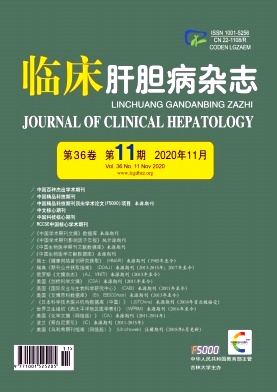|
[1] BRAY F,FERLAY J,SOERJOMATARAM I,et al. Global cancer statistics 2018:GLOBOCAN estimates of incidence and mortality worldwide for 36 cancers in 185 countries[J]. CA Cancer J Clin,2018,68(6):394-424.
|
|
[2] CHEN W,ZHENG R,BAADE PD,et al. Cancer statistics in China,2015[J]. CA Cancer J Clin,2016,66(2):115-132.
|
|
[3] RENG ZG. Immunotherapy for hepatocellular carcinoma[J]. J Clin Hepatol,2018,34(7):1371-1373.(in Chinese)任正刚.肝细胞癌的免疫治疗[J].临床肝胆病杂志,2018,34(7):1371-1373.
|
|
[4] BAGHDADI M,JINUSHI M. The impact of the TIM gene family on tumor immunity and immunosuppression[J]. Cell Mol Immunol,2014,11(1):41-48.
|
|
[5] SACHDEVA M,CHAWLA YK,ARORA SK. Immunology of hepatocellular carcinoma[J]. World J Hepatol,2015,7(17):2080-2090.
|
|
[6] LAN F,LI RM,YANG LY,et al. Anti-tumor immune therapy with programmed death-1 and its ligand inhibitors:research advances[J]. J Int Pharm Res,2016,43(5):813-817.(in Chinese)兰芬,李睿旻,阳凌燕,等.程序性细胞死亡蛋白1及其配体抑制剂抗肿瘤免疫治疗进展[J].国际药学研究杂志,2016,43(5):813-817.
|
|
[7] JOYCE JA,FEARON DT. T cell exclusion,immune privilege,and the tumor microenvironment[J]. Science,2015,348(6230):74-80.
|
|
[8] MONNEY L,SABATOS CA,GAGLIA JL,et al. Th1-specific cell surface protein Tim-3 regulates macrophage activation and severity of an autoimmune disease[J]. Nature,2002,415(6871):536-541.
|
|
[9] ANDERSON AC,ANDERSON DE,BREGOLI L,et al. Promotion of tissue inflammation by the immune receptor Tim-3 expressed on innate immune cells[J]. Science,2007,318(5853):1141-1143.
|
|
[10] JU Y,HOU N,MENG J,et al. T cell immunoglobulin-and mucin-domain-containing molecule-3(Tim-3)mediates natural killer cell suppression in chronic hepatitis B[J]. J Hepatol,2010,52(3):322-329.
|
|
[11] WU W,SHI Y,LI S,et al. Blockade of Tim-3 signaling restores the virus-specific CD8+T-cell response in patients with chronic hepatitis B[J]. Eur J Immunol,2012,42(5):1180-1191.
|
|
[12] ANDERSON AC. Tim-3,a negative regulator of anti-tumor immunity[J]. Curr Opin Immunol,2012,24(2):213-216.
|
|
[13] PATEL J,BOZEMAN EN,SELVARAJ P. Taming dendritic cells with TIM-3:Another immunosuppressive strategy used by tumors[J]. Immunotherapy,2012,4(12):1795-1798.
|
|
[14] HARDING JJ,EL DIKA I,ABOU-ALFA GK. Immunotherapy in hepatocellular carcinoma:Primed to make a difference?[J]. Cancer,2016,122(3):367-377.
|
|
[15] JI M,LIU Y,LI Q,et al. PD-1/PD-L1 pathway in nonsmall-cell lung cancer and its relation with EGFR mutation[J]. J Transl Med,2015,13:5.
|
|
[16] FREEMAN-KELLER M,WEBER JS. Anti-programmed death receptor 1 immunotherapy in melanoma:Rationale,evidence and clinical potential[J]. Ther Adv Med Oncol,2015,7(1):12-21.
|
|
[17] HUANG RY,EPPOLITO C,LELE S,et al. LAG3 and PD1 co-inhibitory molecules collaborate to limit CD8+T cell signaling and dampen antitumor immunity in a murine ovarian cancer model[J]. Oncotarget,2015,6(29):27359-27377.
|
|
[18] SHINOHARA T,TANIWAKI M,ISHIDA Y,et al. Structure and chromosomal localization of the human PD-1 gene(PDCD1)[J]. Genomics,1994,23(3):704-706.
|
|
[19] FRANCISCO LM,SAGE PT,SHARPE AH. The PD-1 pathway in tolerance and autoimmunity[J]. Immunol Rev,2010,236:219-242.
|
|
[20] LIU LX,CAI W. Current situation and prospect of immunotherapy for hepatocellular carcinoma[J]. Chin J Dig Surg,2020,19(2):119-122.(in Chinese)刘连新,蔡伟.肝细胞癌免疫治疗的现状和展望[J].中华消化外科杂志,2020,19(2):119-122.
|
|
[21] FIFE BT,PAUKEN KE,EAGAR TN,et al. Interactions between PD-1 and PD-L1 promote tolerance by blocking the TCR-induced stop signal[J]. Nat Immunol,2009,10(11):1185-1192.
|
|
[22] ZHU C,ANDERSON AC,KUCHROO VK. TIM-3 and its regulatory role in immune responses[J]. Curr Top Microbiol Immunol,2011,350:1-15.
|
|
[23] SOLINAS G,GERMANO G,MANTOVANI A,et al. Tumorassociated macrophages(TAM)as major players of the cancer-related inflammation[J]. J Leukoc Biol,2009,86(5):1065-1073.
|
|
[24] BISWAS SK,MANTOVANI A. Macrophage plasticity and interaction with lymphocyte subsets:Cancer as a paradigm[J].Nat Immunol,2010,11(10):889-896.
|
|
[25] MASSAGUE J. TGFbeta in cancer[J]. Cell,2008,134(2):215-230.
|
|
[26] YAN WJ. TGFβenhanced Tim-3 expression on macrophages fosters M2-like alternative activation contributing to HCC[D].Jinan:Shandong University,2014.(in Chinese)阎文江.Tim-3在肿瘤相关巨噬细胞极化及肝细胞肝癌进展中的作用及机制研究[D].济南:山东大学,2014.
|
|
[27] LI Z,LI N,LI F,et al. Immune checkpoint proteins PD-1 and TIM-3 are both highly expressed in liver tissues and correlate with their gene polymorphisms in patients with HBV-related hepatocellular carcinoma[J]. Pubmed, 2016, 95(52):e5749.
|







 DownLoad:
DownLoad: